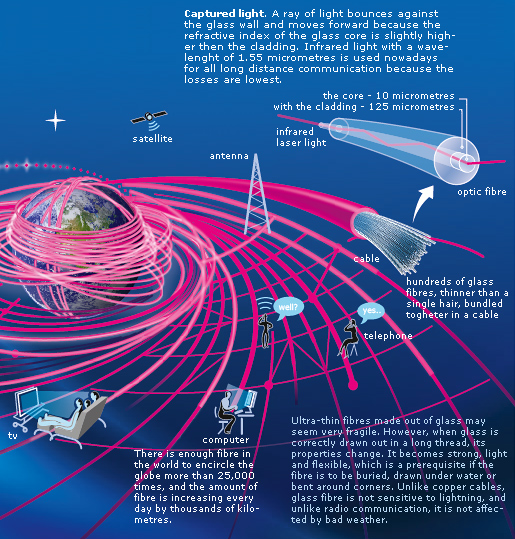Illustrated information
Nobel Poster from the Nobel Committee for Physics, web adapted by Nobel Web
Contents
The masters of light
Further reading
Credits
The Royal Swedish Academy of Sciences has decided to award the Nobel Prize in Physics for 2009 with one half to Charles K. Kao, “for groundbreaking achievements concerning the transmission of light in fibres for optical communication” and the other half jointly to Willard S. Boyle and George E. Smith “for the invention of an imaging semiconductor circuit – the CCD sensor“.
The masters of light
Information rushes through highways of glass at the speed of light. Pictures become digital inside the camera. The 2009 Nobel Prize is awarded for two scientific achievements that have helped to shape the foundations of today’s networked societies. They have created many practical innovations for everyday life and provided new tools for scientific exploration.
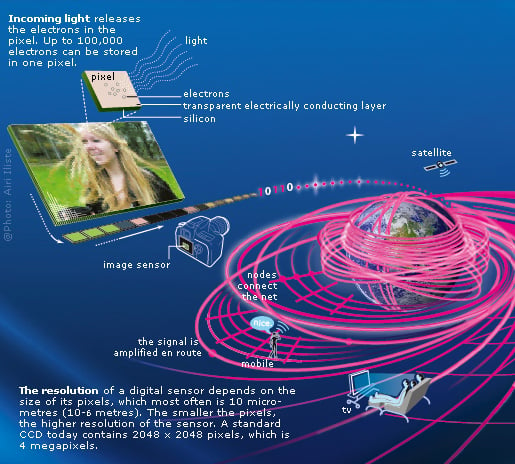
Half of the prize is awarded to Charles Kao who made a discovery that led to a breakthrough for fibre-optic communication. Today optical fibres make up the circulatory system that nourishes our information society. Light flows in threads of glass, as thin as a hair, which carries almost all of the telephony and data traffic in each and every direction. Without optical fibres there would be no internet nor broadband. A large share of the traffic is made up of digital images, which constitute the second part of the award. In 1969 Willard S. Boyle and George E. Smith invented the first successful imaging technology using a digital sensor, a CCD (Charge-Coupled Device). The CCD revolutionized photography, as light could now be captured electronically instead of on film.
The image sensor, CCD, is the advanced digital camera’s electronic eye. Incoming light releases electrons in the CCD’s photocells, the pixels. The more light, the more electrons are collected in
The CCD array is read out row by row. Electrons slide off the array onto an electronic conveyor belt and are subsequently translated into digital ones and zeros. This digital form makes it easy to manipulate and transfer the images.
Every pixel is a silicon mini-capacitor built in layers that collects the electrons. A variable electric voltage is used for reading out the pixels. In this simple but ingenious way, almost the entire area of the sensor is used to collect light, creating the high performance of the CCD.

Original notes. During a short brainstorm meeting on September 8, 1969 (according to the notes), Willard Boyle and George Smith made the first sketch of a CCD. Photography was not what they had in mind, but very soon CCD became the first truly successful technology for the digital recording of images.
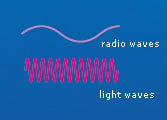
Compared to radio waves, light carries tens of thousands times more information because of its much higher frequencies. But ways to transmit light signals over longer distances were still not known in the first half of the 1960’s. After just 20 metres, only 1 percent of the light that had entered a glass fibre remained. Reducing this loss of light became a challenge for a visionary like Charles Kao.
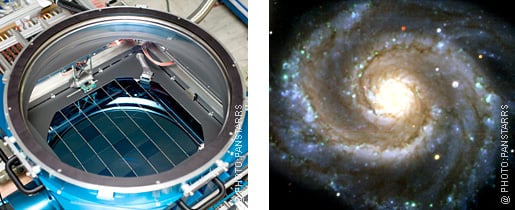
Early on, astronomers realized the advantages of the digital image sensor. It spans the entire light spectrum, from X-ray to infrared. It is a much more sensitive than photographic film: out of 100 incoming light particles, CCD catches up to 90, whereas photographic film will only catch one.
Left: the world’s largest digital camera ever, built at the University of Hawaii. Its 40 square centimetres surface contains 64 x 64 CCDs, 1.4 billion pixels in total. Astronomers hope that telescopes equipped with such cameras will find 5,000 new supernovas as well as detect asteroids in potentially threatening trajectories towards Earth.
Right: spiral galaxy M51 in the constellation Canes Venatici is one of the first images taken with this digital camera.
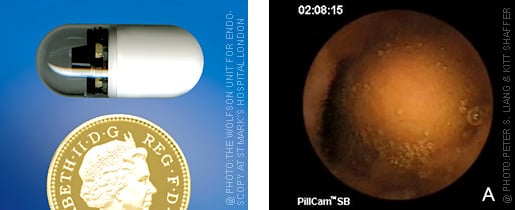
Medicine. CCD technology is used in a host of medical applications, e.g. imaging the inside of the human body, both for surgical operations and for diagnostics such as endoscopy.
Left: endoscopy capsule carrying a digital camera and a radio transmitter. Once swallowed by the patient, the capsule wanders along the digestion system and sends images like this from a 21 year old woman with cancer of the small intestine, right.
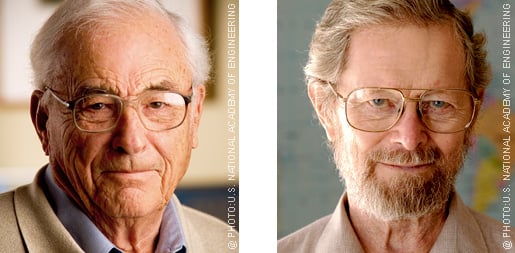 |
||
Willard BoyleCanadian and US citizen. Willard Boyle was born in Nova Scotia, Canada, and was educated at home by his mother until the age of 15. He began to work at Bell Labs in 1953, and in the 1960’s he joined the 400,000 scientists in the USA whose efforts were to put the first man on the moon on 20 July 1969. |
George SmithUS citizen. Born 1930 in White Plains, NY, USA. George Smith was hired at Bell Labs in 1959, and took out thirty patents during his time at the company. When he retired in 1986, he could finally dedicate himself fully to his life-long passion – sailing on the great seas, which has brought him around the globe many times. |
|
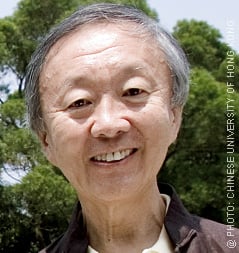
Charles Kao
British and US citizen. Born 1933 in Shanghai, China.
Charles Kao was born in 1933 in Shanghai. He moved to Hong Kong together with his family in 1948. Educated as an electronics engineer, he defended his Ph.D. thesis in 1965 in London. By that time he was already employed at the Standard Telecommunication Laboratories, where he meticulously studied glass fibre together with his young colleague George A. Hockham. In January 1966, he presented his conclusions. It was not imperfections in the fibre thread that was the main problem, instead it was the glass that had to be purified. The goal was to manufacture glass of a transparency that had never been attained before. Four years later the first fibres that fulfilled Kao’s vision were developed. Nowadays, several terabits per second can be transmitted in a single fibre. This represents an increase by a factor of one million to what could be achieved fifty years ago with radio signal transmission.
Further reading!
Information on the Nobel Prize in Physics 2009: http://kva.se, http://nobelprize.org
Smith, G.E. (2009) The invention and early history of the CCD. Nuclear Instruments and Methods in Physics Research A, 607, pp. 1–6.
Janesick, J.R. (2001) Scientific Charge-Coupled Devices. SPIE Press Monograph Vol. PM83.
Hecht, J. (1991) City of Light: The Story of Fiber Optics. Oxford University Press.
Su, F. (1990) Technology of our times: people and innovation in optics and optoelectronics. SPIE Press, pp. 80–95.
Scientific articles:
Kao, C. K., Hockham, G.A. (1966) Dielectric-fibre Surface Waveguides for Optical Frequencies. Proceedings of the Institution of Electrical Engineers-London 113, p. 1151.
Boyle, W.S., Smith, G.E. (1970) Charge Couple Semiconductor Devices. Bell System Technical Journal 49, p. 587.
Link:
www.jyi.org/volumes/volume3/issue1/features/peterson.html
Credits and references for the 2009 Nobel Poster for Physics
Editors: Joseph Nordgren, Chair, Lars Bergström, Secr., Anne L’Huillier and Ingemar Lundström, Members, the Nobel Committee for Physics, Joanna Rose, Science Journalist, Annika Moberg, Editor and Ylva Sjöberg, Nobel Assistant, The Royal Swedish Academy of Sciences.
Illustration: Airi Iliste
Layout: Typoform
Printing: Åtta.45 Tryckeri AB
Copyright © The Royal Swedish Academy of Sciences
Box 50005, SE-104 05 Stockholm, Sweden
Phone:+46 8 673 95 00, fax: +46 8 15 56 70
e-mail: [email protected], http://kva.se/
Posters may be ordered free of charge by e-mail to [email protected], phone or fax.
Web adapted version: Nobelprize.org
Nobel Prizes and laureates
Six prizes were awarded for achievements that have conferred the greatest benefit to humankind. The 14 laureates' work and discoveries range from quantum tunnelling to promoting democratic rights.
See them all presented here.
